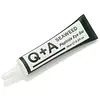What's inside
What's inside
 Key Ingredients
Key Ingredients

 Benefits
Benefits

 Concerns
Concerns

 Ingredients Side-by-side
Ingredients Side-by-side

Water
Skin ConditioningGlycerin
HumectantDicaprylyl Carbonate
EmollientPropanediol
SolventPolyglyceryl-6 Distearate
EmulsifyingCetyl Alcohol
EmollientGlyceryl Behenate
EmollientPhenoxyethanol
PreservativeHydroxyethyl Acrylate/Sodium Acryloyldimethyl Taurate Copolymer
Emulsion StabilisingJojoba Esters
EmollientAlbizia Julibrissin Bark Extract
MaskingSqualane
EmollientCaffeine
Skin ConditioningPolyglyceryl-3 Beeswax
EmulsifyingPhospholipids
Skin ConditioningEthylhexylglycerin
Skin ConditioningXanthan Gum
EmulsifyingGlycine Soja Oil
EmollientPolysorbate 60
EmulsifyingSodium Phytate
Glycolipids
Skin ConditioningSorbitan Isostearate
EmulsifyingButylene Glycol
HumectantCitric Acid
BufferingGlycine Soja Sterols
EmollientLeuconostoc/Radish Root Ferment Filtrate
AntimicrobialHyaluronic Acid
HumectantSodium Benzoate
MaskingTocopherol
AntioxidantCarbomer
Emulsion StabilisingDarutoside
Skin ConditioningSodium Lactate
BufferingPolysorbate 20
EmulsifyingPalmitoyl Tetrapeptide-7
Skin ConditioningPalmitoyl Tripeptide-1
Skin ConditioningWater, Glycerin, Dicaprylyl Carbonate, Propanediol, Polyglyceryl-6 Distearate, Cetyl Alcohol, Glyceryl Behenate, Phenoxyethanol, Hydroxyethyl Acrylate/Sodium Acryloyldimethyl Taurate Copolymer, Jojoba Esters, Albizia Julibrissin Bark Extract, Squalane, Caffeine, Polyglyceryl-3 Beeswax, Phospholipids, Ethylhexylglycerin, Xanthan Gum, Glycine Soja Oil, Polysorbate 60, Sodium Phytate, Glycolipids, Sorbitan Isostearate, Butylene Glycol, Citric Acid, Glycine Soja Sterols, Leuconostoc/Radish Root Ferment Filtrate, Hyaluronic Acid, Sodium Benzoate, Tocopherol, Carbomer, Darutoside, Sodium Lactate, Polysorbate 20, Palmitoyl Tetrapeptide-7, Palmitoyl Tripeptide-1
Water
Skin ConditioningAloe Barbadensis Leaf Juice
Skin ConditioningGlycerin
HumectantHamamelis Virginiana Water
AstringentTripeptide-29
Skin ConditioningFucus Vesiculosus Extract
EmollientChondrus Crispus Extract
Skin ConditioningLimonium Vulgare Flower/Leaf/Stem Extract
Skin ConditioningLaminaria Digitata Extract
Skin ProtectingThymus Serpyllum Extract
Skin ConditioningSodium Gluconate
Skin ConditioningCarbomer
Emulsion StabilisingLeuconostoc/Radish Root Ferment Filtrate
AntimicrobialPotassium Sorbate
PreservativePhenoxyethanol
PreservativeCaprylyl Glycol
EmollientSodium Benzoate
MaskingSodium Hydroxide
BufferingAlcohol
AntimicrobialCitric Acid
BufferingWater, Aloe Barbadensis Leaf Juice, Glycerin, Hamamelis Virginiana Water, Tripeptide-29, Fucus Vesiculosus Extract, Chondrus Crispus Extract, Limonium Vulgare Flower/Leaf/Stem Extract, Laminaria Digitata Extract, Thymus Serpyllum Extract, Sodium Gluconate, Carbomer, Leuconostoc/Radish Root Ferment Filtrate, Potassium Sorbate, Phenoxyethanol, Caprylyl Glycol, Sodium Benzoate, Sodium Hydroxide, Alcohol, Citric Acid
 Reviews
Reviews

Ingredients Explained
These ingredients are found in both products.
Ingredients higher up in an ingredient list are typically present in a larger amount.
Carbomer is a polymer of acrylic acid. Its main role is to create a gel consistency.
A high amount of carbomer can cause pilling or balling up of products. Don't worry, most products contain 1% or less of carbomer.
Citric Acid is an alpha hydroxy acid (AHA) naturally found in citrus fruits like oranges, lemons, and limes.
Like other AHAs, citric acid can exfoliate skin by breaking down the bonds that hold dead skin cells together. This helps reveal smoother and brighter skin underneath.
However, this exfoliating effect only happens at high concentrations (20%) which can be hard to find in cosmetic products.
Due to this, citric acid is usually included in small amounts as a pH adjuster. This helps keep products slightly more acidic and compatible with skin's natural pH.
In skincare formulas, citric acid can:
While it can provide some skin benefits, research shows lactic acid and glycolic acid are generally more effective and less irritating exfoliants.
Most citric acid used in skincare today is made by fermenting sugars (usually from molasses). This synthetic version is identical to the natural citrus form but easier to stabilize and use in formulations.
Read more about some other popular AHA's here:
Learn more about Citric AcidGlycerin is already naturally found in your skin. It helps moisturize and protect your skin.
A study from 2016 found glycerin to be more effective as a humectant than AHAs and hyaluronic acid.
As a humectant, it helps the skin stay hydrated by pulling moisture to your skin. The low molecular weight of glycerin allows it to pull moisture into the deeper layers of your skin.
Hydrated skin improves your skin barrier; Your skin barrier helps protect against irritants and bacteria.
Glycerin has also been found to have antimicrobial and antiviral properties. Due to these properties, glycerin is often used in wound and burn treatments.
In cosmetics, glycerin is usually derived from plants such as soybean or palm. However, it can also be sourced from animals, such as tallow or animal fat.
This ingredient is organic, colorless, odorless, and non-toxic.
Glycerin is the name for this ingredient in American English. British English uses Glycerol/Glycerine.
Learn more about GlycerinLeuconostoc/Radish Root Ferment Filtrate is a natural preservative. It comes from fermenting radish roots with a bacteria called leuconostoc.
Leuconostoc comes from lactic acid.
This ingredient has antimicrobial properties and helps prevent the growth of bacteria in a product.
Leuconostoc is used to make the traditional Korean side-dish, kimchi. It is also used to make sourdough bread (both incredibly yummy foods).
Learn more about Leuconostoc/Radish Root Ferment FiltratePhenoxyethanol is a preservative that has germicide, antimicrobial, and aromatic properties. Studies show that phenoxyethanol can prevent microbial growth. By itself, it has a scent that is similar to that of a rose.
It's often used in formulations along with Caprylyl Glycol to preserve the shelf life of products.
Sodium Benzoate is a preservative. It's used in both cosmetic and food products to inhibit the growth of mold and bacteria. It is typically produced synthetically.
Both the US FDA and EU Health Committee have approved the use of sodium benzoate. In the US, levels of 0.1% (of the total product) are allowed.
Sodium benzoate works as a preservative by inhibiting the growth of bacteria inside of cells. It prevents the cell from fermenting a type of sugar using an enzyme called phosphofructokinase.
It is the salt of benzoic acid. Foods containing sodium benzoate include soda, salad dressings, condiments, fruit juices, wines, and snack foods.
Studies for using ascorbic acid and sodium benzoate in cosmetics are lacking, especially in skincare routines with multiple steps.
We always recommend speaking with a professional, such as a dermatologist, if you have any concerns.
Learn more about Sodium BenzoateWater. It's the most common cosmetic ingredient of all. You'll usually see it at the top of ingredient lists, meaning that it makes up the largest part of the product.
So why is it so popular? Water most often acts as a solvent - this means that it helps dissolve other ingredients into the formulation.
You'll also recognize water as that liquid we all need to stay alive. If you see this, drink a glass of water. Stay hydrated!
Learn more about Water